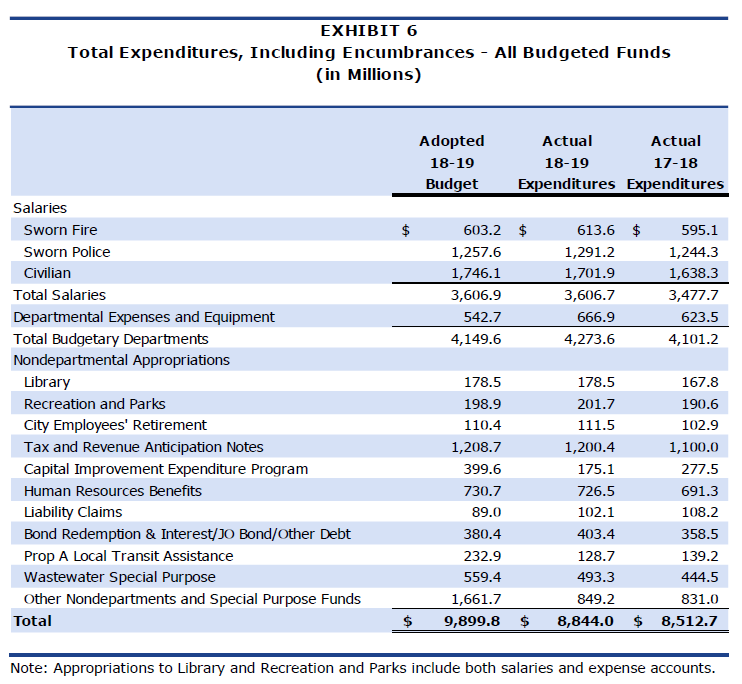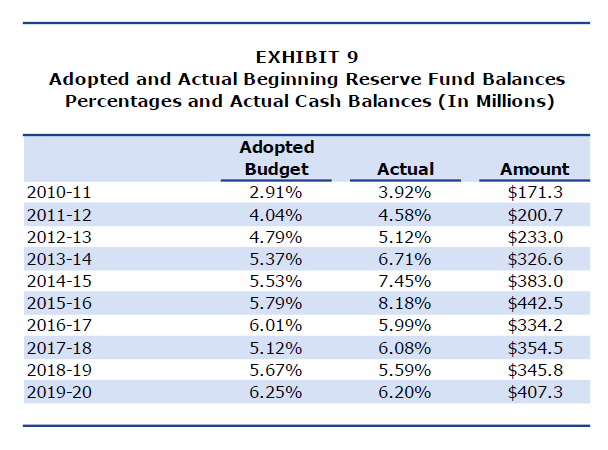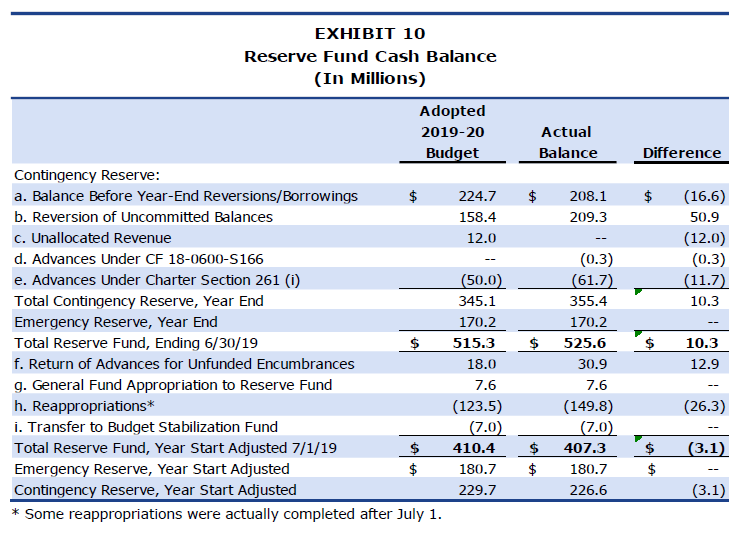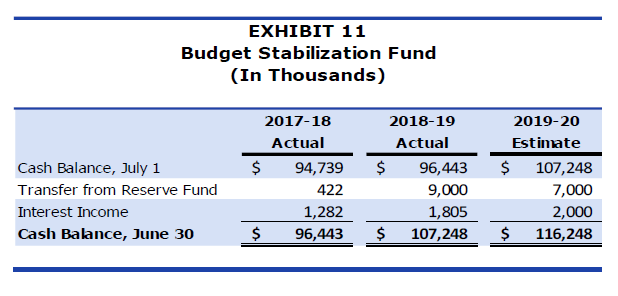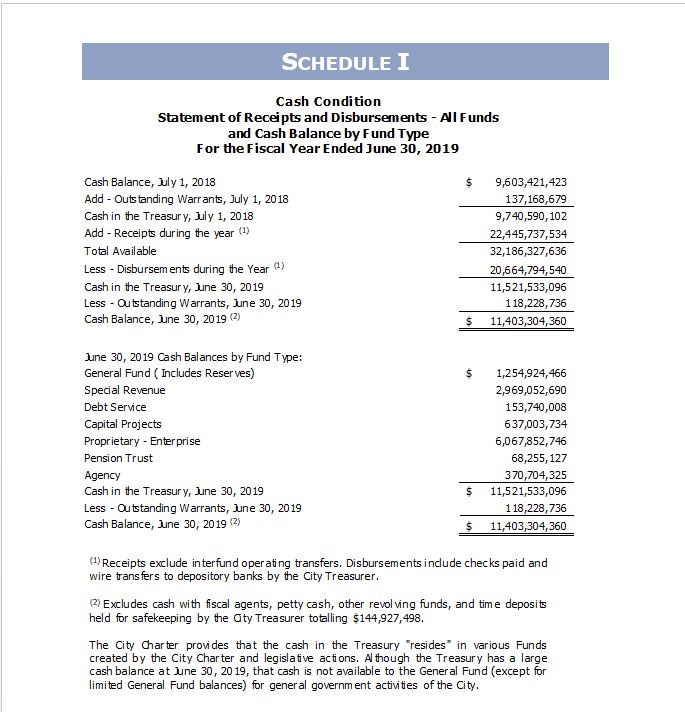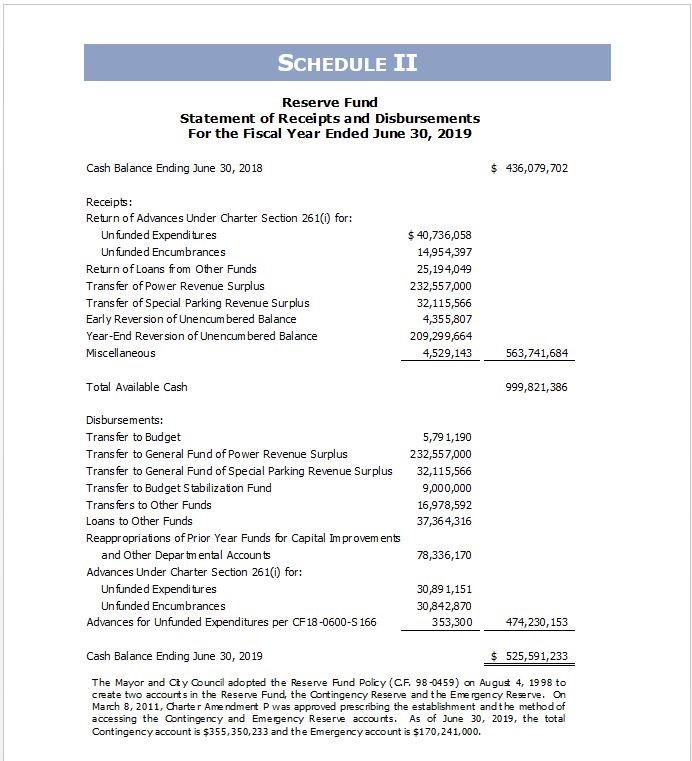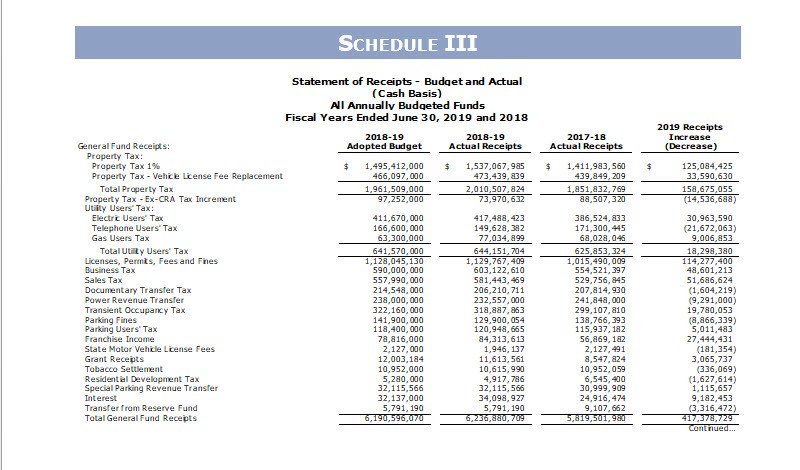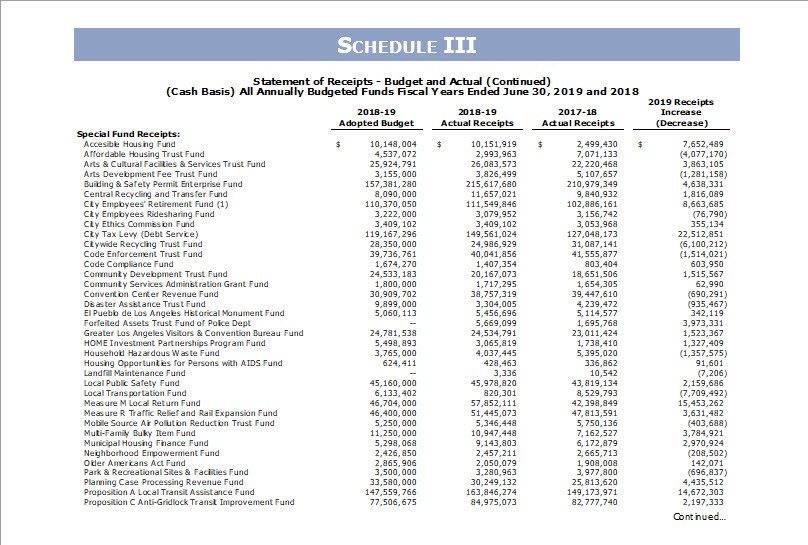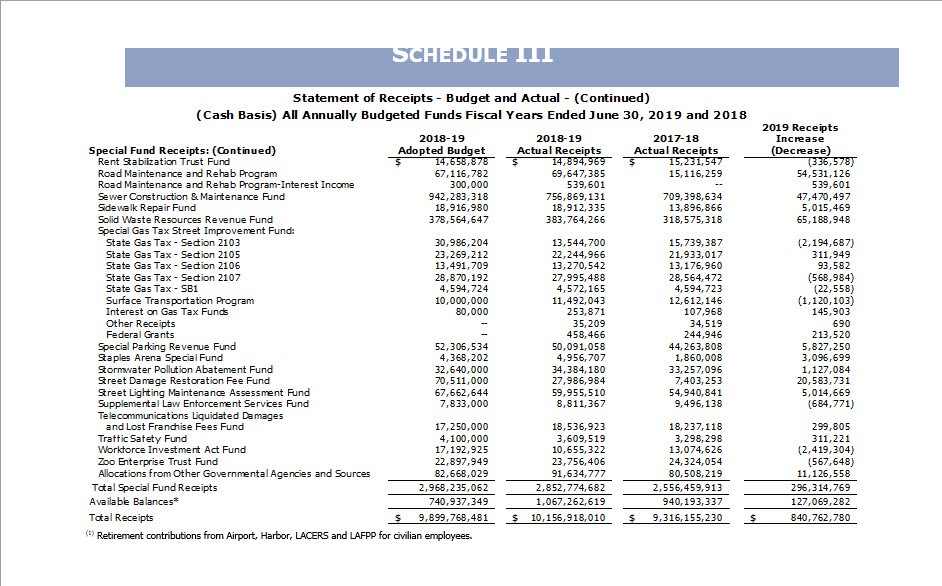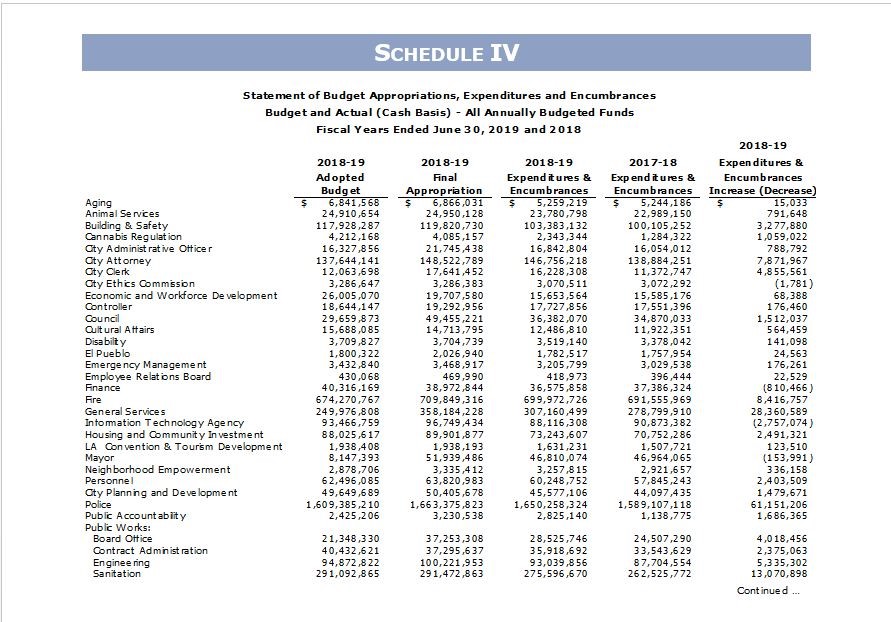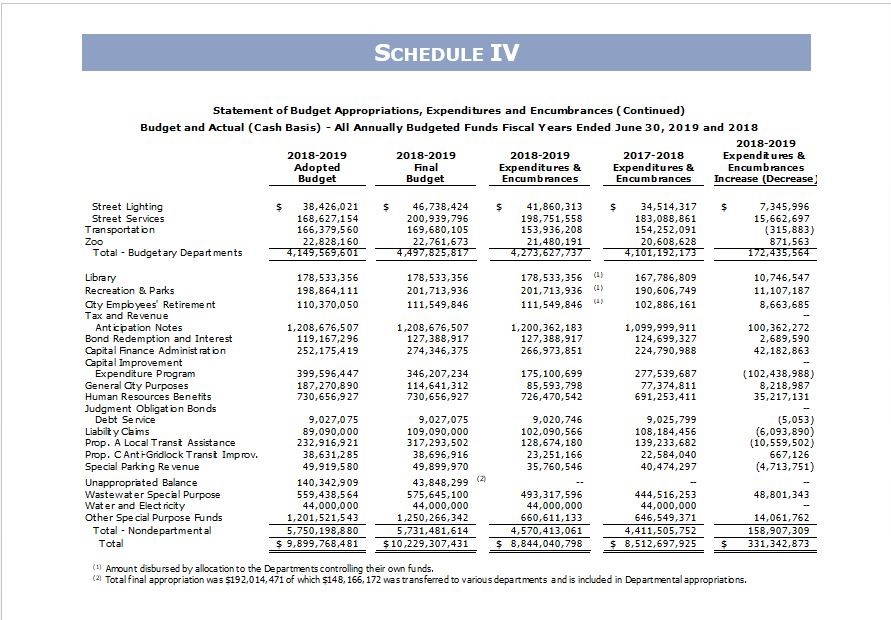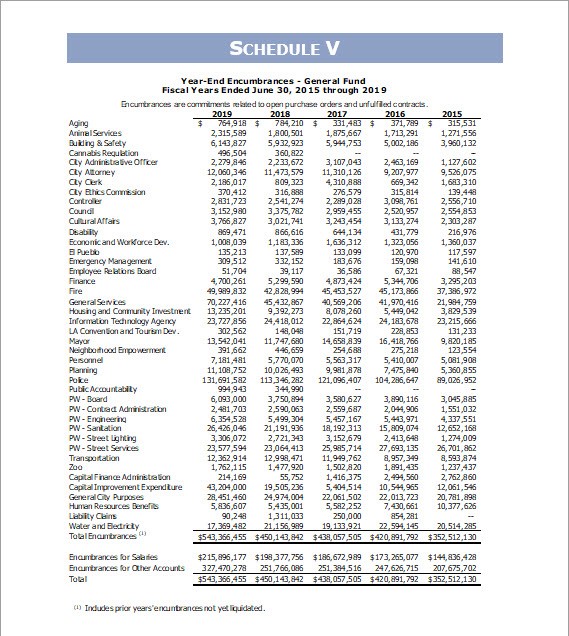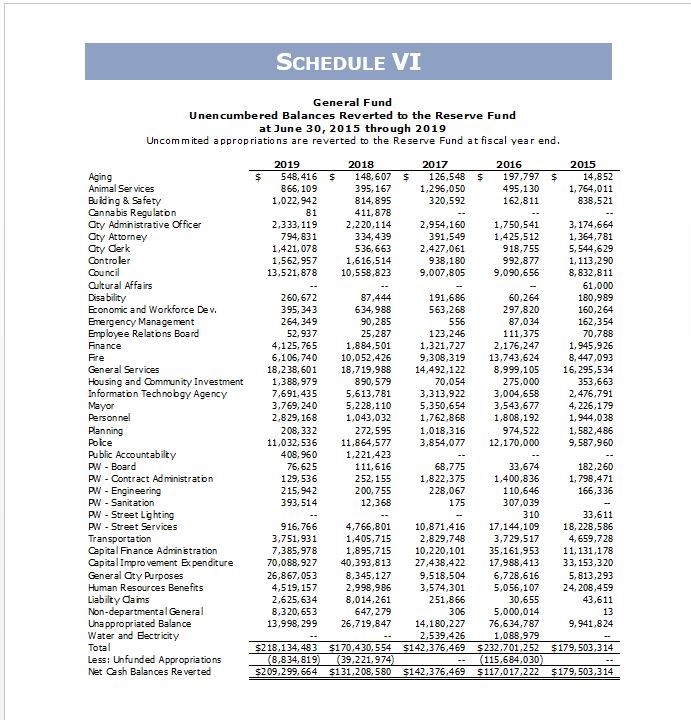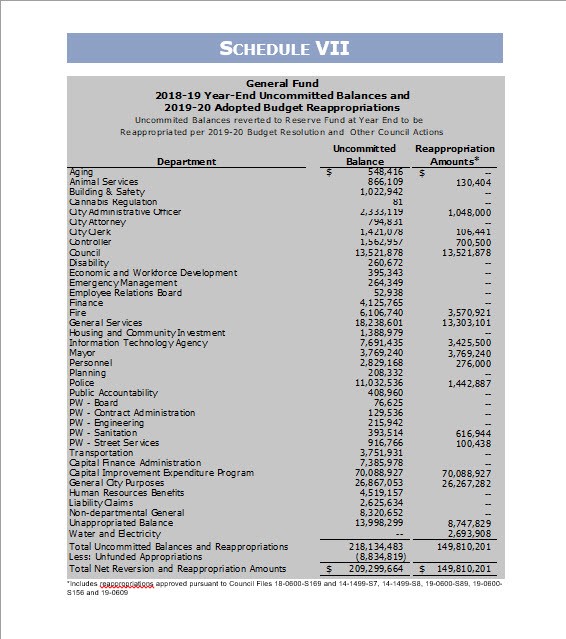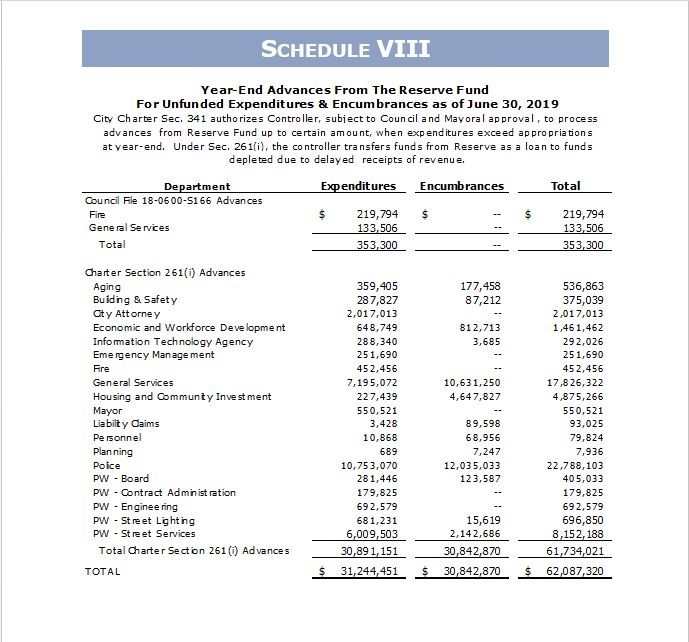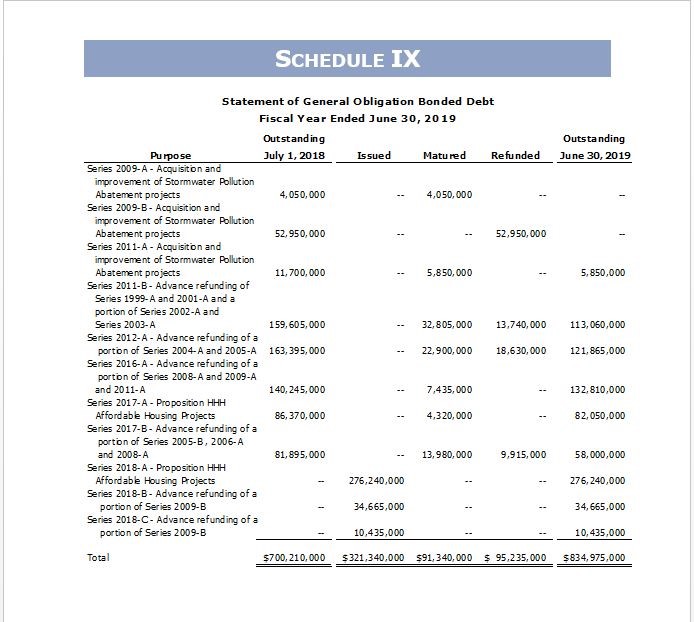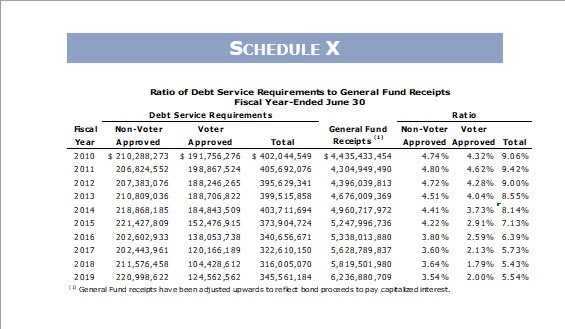Preliminary Financial Report FY19
Interactive Preliminary Financial Report 2019
A first look at the City’s financial performance in the fiscal year ending June 30, 2019
In May 2018, the City Council approved a budget of $9.9 billion for the fiscal year from July 1, 2018 through June 30, 2019. The Preliminary Financial Report provides data and analysis of the City’s revenues and expenditures for that fiscal year. It details where the City’s budgeted funds came from, how they were spent and more.
Why Is This Report Important?
One of the City Controller’s primary responsibilities is analyzing and reporting on the City’s finances. The reports produced by the Controller inform City officials and the public about the City’s financial activities and financial status. They also aim to initiate meaningful reflection and debate about the City’s fiscal management.
The Preliminary Financial Report, made available each October after the City’s books are closed, is the first of these reports. It provides information on how the City spent its funds over the past fiscal year, featuring data and analysis of the City’s revenues and expenditures, the Reserve Fund, the Budget Stabilization Fund, and the City’s bonded indebtedness.
More complete and detailed information, presented in accordance with Generally Accepted Accounting Practices will be published in the Comprehensive Annual Financial Report in January 2020. Below is an interactive version of the Preliminary Financial Report followed by the full report. You can also download a pdf of the full report on the right side of this page.
Data Visualizations
Revenues
During the 2018-19 fiscal year, revenue grew by 7.2% in the General Fund and 11.6% in on-budget special funds. This was led by all-time high receipts from Property Tax, Business Tax, Sales Tax, and Licenses, Permits, Fees, and Fines. Combining General Fund and on-budget special fund revenue, total revenue increased by 8.6% over 2017-18.
View this interactive data visualization to explore the relative size of the City’s revenue sources and their growth over the past 10 years.
Expenditures
Total expenditures grew at a rate of 4.5%, due in large part to salary and benefit increases. Expenditures are projected to accelerate in the next year, with newly-executed employment contracts for almost every City employee guaranteeing pay increases, as well as projected increases in health care costs and retirement contributions.
This interactive data visualization compares the expenditures of the City’s different departments, as well as non-departmental expenditures, over the past 10 years. View total expenditures, salaries, other expenditures, descriptions of each item, and the change of each item over time.
Reserve Fund and Budget Stabilization Fund
It is crucial that the City build up reserve funds during years of strong growth in order to prepare for future downturns. In the last ten fiscal years, the City’s Reserve Fund rose from 3.9% in July 2009 to its 8.2% peak at the beginning of 2015-16, but has since declined to 6.2% of the 2018-19 Adopted General Fund Budget.
Reserve Fund
The Reserve Fund is established to ensure that funds are available for unanticipated expenditures and revenue shortfalls in the General Fund. The City’s Reserve Fund Policy sets a goal for the Reserve Fund of at least 5% of the General Fund budget every year.
On July 1, 2019, the Reserve Fund had a balance of $404.3 million, 6.2% of the 2019-2020 General Fund budget and $79 million above the 5% Reserve Fund Policy goal.
Budget Stabilization Fund
The Budget Stabilization Fund (BSF) was added to the City Charter in 2011. The purpose of the BSF is to set aside funds when revenue projections are exceeded to help smooth out years when revenue is stagnant or is in decline. In fiscal year 2019, the BSF grew slightly to $107.2 million but stayed about flat as a percentage of General Fund revenues. For the 2020 fiscal year, the adopted budget set aside $7 million to be deposited into the BSF.
Click the chart below to view the performance of the Reserve Fund and Budget Stabilization Fund, both in dollar terms and as a percentage of budgeted General Fund revenues.
Debt
The City’s Debt Management Policy establishes guidelines for the structure and management of the City’s debt obligations. These guidelines include a non-voter-approved debt service cap of 6% and a total debt service cap of 15% as a percent of General Fund revenues.
The City’s total indebtedness and debt service obligations increased slightly for the first time since 2012, due primarily to the issuance of Proposition HHH General Obligation Bonds.
Full Preliminary Financial Report
October 17, 2019
Honorable Eric Garcetti, Mayor
Honorable Members of the Los Angeles City Council
Re: Preliminary Financial Report for Fiscal Year 2018-19
Each fall, the Controller’s office submits the Preliminary Financial Report covering financial operations for the City of Los Angeles for the previous fiscal year. Our report is the City’s first review of municipal finances after the close of the fiscal year, providing an overview and analysis of revenues and expenditures, reserves and bonded indebtedness. In January 2020, my office will follow up by issuing the City’s Comprehensive Annual Financial Report for 2018-19, which is prepared in accordance with Generally Accepted Accounting Principles and externally audited by a firm of certified public accountants.
Accompanying the current Preliminary Financial Report is an online interactive tool for exploring revenues and expenditures, with 10 years of data. Information on special fund balances and uses, Reserve Fund starting balances over the years, and budget appropriations, adjustments, expenditures and revenues, are also available on our website.
The substance and timing of this report make it a vital tool for City leaders to use to assess the overall health of the City’s finances. Knowledge and understanding of the revenue and expenditure trends, the condition of the City’s reserves, and the outstanding debt — all of which are discussed in the report — are critical to ensuring responsible financial management.
A solid year
Highlighted in the Preliminary Financial Report are these facts about the 2018-19 fiscal year:
- Total revenues increased by 8.6 percent to $9.08 billion, while total expenditures rose by 4.5 percent to $8.23 billion. Revenue growth was fueled by all-time high property, business, sales and transient occupancy tax receipts.
- General Fund revenues grew by 7.2 percent to $6.23 billion, while non-proprietary special funds expanded by 11.6 percent to $2.85.
- The Reserve Fund balance ended at 6.2 percent of General Fund receipts anticipated in the 2019-20 Adopted Budget, leaving the City $79 million above its five percent policy goal.
- Cannabis related revenue totaled more than $70 million due to higher than expected business and sales tax receipts.
Concerns remain
A number of concerns are also addressed in the report:
- Pension costs to the City increased last fiscal year by 9.1 percent from $1.1 billion to more than $1.2 billion.
- Total expenditures will continue to grow in the coming years due to increased salary and employee benefit costs in newly-adopted labor agreements. Such costs could put constraints on the City’s ability to expand services in future years, especially if revenues do not keep pace.
- Although transient occupancy tax receipts from hotels and home-sharing increased, they dipped below budgeted amounts for the first time since 2011. The City’s new home-sharing policy, which imposes some limits on short term rentals, could impact the amount collected going forward.
To proactively address these issues, my office recommends that the City further increase the General Fund percentage contributed to the Reserve and Budget Stabilization Funds, and remain cautious when considering future staffing and related spending requests.
It is also worth noting that City’s debt service requirements increased only slightly to 5.5 percent of General Fund revenues ($345.6 million), due to the issuance of the second round of Proposition HHH bonds last year, but remained significantly below the policy limit of 15 percent ($935.5 million). While this can be viewed in a positive light, utilizing debt financing can also provide the opportunity to invest in large-scale infrastructure projects to meet long-term City needs, including street and sidewalk repair and information technology modernization, as recommended in some of my office’s recent reports.
My staff and I appreciate the cooperation shown by City departments as we prepared this report, and we congratulate them for smoothly closing the last fiscal year.
Respectfully submitted,

L.A. Controller
cc: Sharon Tso, Chief Legislative Analyst
Richard H. Llewellyn Jr., City Administrative Officer
Executive Summary
At the close of each fiscal year, the Office of the Controller is required to report on the finances of the City for the year that just ended. This Preliminary Financial Report is the first piece of that reporting provides cash basis information on revenues, expenditures, reserves, and bonded indebtedness, in comparison to the Adopted Budget.
Section I: Revenues and Expenditures
The Preliminary Financial Report focuses on the cash basis financial information of the City for 2018-19, providing information on revenues and expenditures, the Reserve Fund, the Budget Stabilization Fund, and bonded indebtedness.
Audited financial statements, prepared in conformity with Generally Accepted Accounting Principles (GAAP), will be presented in the City’s Comprehensive Annual Financial Report (CAFR) later this fiscal year.
Section II: Reserve Fund
The Reserve Fund is established to ensure that funds are available for unanticipated expenditures and revenue shortfalls in the General Fund, and is broken into an Emergency Account and a Contingency Account.
The Emergency Reserve Account is fixed at 2.75 percent of the adopted General Fund receipts. A finding of urgent economic necessity is required to use these funds. The Contingency Reserve Account includes all monies in the Reserve Fund over and above the amount required to be allocated to the Emergency Account. Contingency Reserve Account funds can be a source of additional funding to cover unanticipated expenses or revenue shortfalls.
Section III: Budget Stabilization Fund
The Budget Stabilization Fund (BSF) was added to the City’s Charter in 2011. The purpose of this fund is to set aside revenues during periods of robust economic growth or when revenue projections are exceeded to help smooth out years when revenue is stagnant or is in decline.
Section IV: Bonded Indebtedness
The City’s Debt Management Policy establishes guidelines for the structure and management of the City’s debt obligations. These guidelines include target and ceiling levels for certain debt ratios to be used for planning purposes. The two most significant ratios are a non-voter-approved debt service cap as a percent of General Fund revenues of 6 percent and a total debt service cap as a percent of General Fund revenues of 15 percent.
